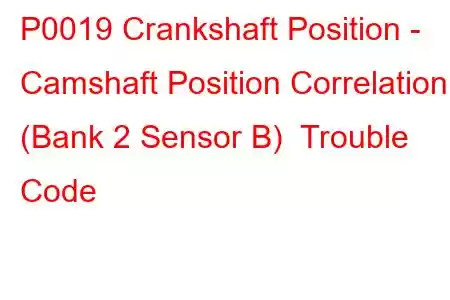P0019 - Crankshaft Position - Camshaft Position Correlation (Bank 2 Sensor B)
Crankshaft Position - Camshaft Position Correlation (Bank 2 Sensor B)
What does that mean?
This diagnostic trouble code (DTC) is a generic powertrain code, which means that it applies to OBD-II equipped vehicles, including but not limited to Ford, Dodge, Toyota, VW, Honda, Chevrolet, Hyundai, Audi, Acura, etc.
The crankshaft position sensor (CKP) and Camshaft position sensor (CMP) work in harmony to control the spark/fuel delivery and timing. They both consist of a reluctor, or tone, ring which passes over a magnetic sensor, which generates a voltage, indicating position.
The crankshaft sensor is part of the primary ignition system and functions as the "trigger". It detects the position of the crankshaft relays that information on to the PCM or the ignition module (depending on the vehicle) to control spark timing. The Camshaft position sensor detects the position of the camshafts and relays the information to the PCM. The PCM uses the CMP signal to identify the beginning of the injector sequence. What ties these two shafts and their sensors together is the timing belt or chain. The cam and crank should be precisely timed together.
If the PCM detects that the crank and cam signals are out of time by a specific number of degrees, this DTC will set. Bank 2 is the side of the engine that contains cylinder #1, the "B" sensor is most likely the exhaust camshaft side.
Note it is not uncommon on certain models to see this DTC in conjuction with P0008, P0009, P0016, P0017, and P0018. If you have a GM vehicle and have those multiple DTCs, check for service bulletins that may apply to your engine.
Symptoms
Symptoms of a P0019 will or may include:
Malfunction Indicator Lamp (MIL) illumination The engine may run but with reduced performance The engine may crank but not start The engine may exhibit a rattle near the harmonic balancer indicating the tone ring is damaged The engine may start and run, but poorlyCauses
Causes may include:
Timing chain stretched, or timing belt skipped a tooth due to wear Misalignment of timing belt/chain Tone ring on crankshaft slipped/broken Tone ring on camshaft slipped/broken Bad crank sensor Bad cam sensor Damaged wiring to crank/cam sensor Timing belt/chain tensioner damaged An improperly torqued crankshaft balancer A mis-built or mis-timed engine A loose or missing crankshaft balancer bolt The CMP actuator solenoid stuck open The CMP actuator stuck in a position other than 0 degreesPossible Solutions
If your vehicle is new enough that is still has powertrain warranty, please let the dealer perform the repairs.
First, visually inspect the cam and crank sensors and their harnesses for damage. If you notice broken/frayed wires, repair and recheck. If you have access to a scope, check the cam and crank patterns. If a pattern is missing, suspect a bad sensor or a slipping tone ring. Remove the cam gear and the crankshaft harmonic balancer and inspect the tone rings for proper alignment and make sure they're not loose or damaged or that they haven't sheared the key that aligns them. If they are properly installed, replace the sensor. If the signal appears normal, then check the timing chain/belt for proper alignment. If it's misaligned, check for a damaged tensioner that may have allowed the chain/belt to slip a tooth or several teeth. Also check that the belt/chain isn't stretched. Repair and recheck.Please consult a factory service repair manual if you need vehicle specific information.
Read: 58


